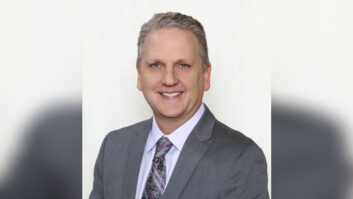A thoughtful broadcaster told me recently he’s feeling a little “whipsawed” regarding the health of the U.S. commercial radio industry.
I can’t use his full name but wanted to share his perspectives as we head into another NAB Show season. Issues he cites are likely to be dominant during that convention and beyond. Just call him Mike.
In short, Mike feels that free local radio is getting very mixed messages.
Radio stocks are down hugely, of course, and although other media stocks are off as well, radio’s performance is one of the worst. Its share of the ad revenue pie has shrunk from 8 percent to 6.8 percent, according to some sources; share peaked in 2003 and has been steadily declining since then, despite talk at that time of increasing it. We also hear that radio is losing ground and over-leveraged, and that if revenues decline just a few percentage points, radio might have to start increasing leverage just to stay afloat. We also have been told that if radio EBITDA (earnings before interest, taxes, depreciation and amortization) were to decline much further, a lot of companies could face bankruptcy.
Have we thought this through?
In recent months radio industry leaders have talked about how the industry is dealing with these challenges. Lew Dickey of Cumulus Media has argued that radio needs to resist commoditization of its product, the urge to lower spot rates too far in efforts to outbid other stations for ad dollars.
“The problem with Lew Dickey’s vision is, it’s illegal,” Mike writes. “The government takes a very dim view of price fixing and other anti-competitive behavior. I’m sure he knows this, for he’s a smart guy and he never talks enough specifics to get to the point of actually attempting to fix prices. And I suppose we have to forgive him, since our business is so intertwined with the music industry and its ridiculous and sometimes illegal business practices. But price fixing is not a realistic plan for radio’s future.”
Meanwhile Dan Mason of CBS Radio has lamented the fact that the FCC did not mandate HD Radio capability in Sirius XM receivers as part of its approval of the merger. That causes alarm for Mike: “The ability of CE companies to differentiate their products from one another is important, and government mandates make differentiation more difficult. And as a consumer, I hate it when I have to buy things that I don’t want in order to get things that I do want.”
Researchers have also told radio managers that, among younger listeners, satellite radio hasn’t really been a big hit. Maybe this is what broadcaster Russ Withers was thinking when he told FCC Chairman Kevin Martin at the fall NAB Radio Show that he would gladly accept a requirement that Sirius XM tuners be included in HD Radio receivers in exchange for a requirement that Sirius XM receivers include an HD Radio tuner.
“Russ, have you really thought this through?” Mike wonders. “Mel Karmazin already expressed interest in sending free programming to inactive satellite radios. Are you sure it’s in your best interest to force receiver manufacturers to put satellite tuners in your listeners’ radios?”
Mike was pleased though to hear Mason say that it’s important to get CBS stations available on iPhones. David Goodman, president of digital media and integrated marketing for CBS Radio, has made a strong case for CBS’ expansion on the Internet through its work with AOL Radio and streaming of CBS stations.
“CBS’ commitment to unilaterally turning iPhones and other portable devices into free local radio receivers by making compatible streams available on the Web is awesome,” Mike said. He echoes a suggestion that Dave Wilson of the Consumer Electronics Association made in RW last year that the radio industry could band together on one Web site, effectively turning portable devices like the iPhone into radio tuners with thousands of free local channels.
“Wilson said the National Association of Realtors runs a site that lets you ‘tune’ to any real estate listing throughout the country, so why can’t the National Association of Broadcasters do the same thing for radio?”
‘This is terrific!’
Then there’s the Radio Heard Here campaign. Our faithful observer says, “My initial reaction was, ‘What are they thinking?’ There are many types of radio out there today: satellite radio, Internet radio, cable radio, and of course free local radio. How does promoting ‘radio’ help the latter compete with the others? It was as if the city of Austin wanted to increase tourism and developed a campaign to achieve this goal called ‘Visit Texas.’ Also, the graphic images I’ve seen associated with the campaign seem to focus almost entirely on non-Internet and non-handheld receivers, which to me seemed to reinforce the perception that free local radio is old technology.”
But two things have warmed him up: the discovery that RadioHeardHere.com serves as a portal to local stations’ Internet streams — “This is terrific!” — and the decision to have individual stations customize the logo for their brands with “WXYZ Heard Here,” “Z104 Heard Here,” etc., using the same logo design.
“Now I see how this brand can be used to distinguish free local radio from other forms of radio. I think NAB, RAB and the HD Radio Alliance are doing some good work, for an omnipresent logo customized with different brand names seems likely to drive home the message that free local radio is an omnipresent service with many different offerings.” He said they still need to work on presenting radio as modern and relevant and on promoting the portal so that listeners see it as thousands of stations in one place.
“The key is to make the free local radio portal the only place to go for AM/FM stations online, so that listeners are drawn there and not to other portals that also offer non-AM/FM streams, which can entice listeners away from free local radio.”
But his “whipsaw” feeling continues when Mike hears David Rehr of NAB talk about how radio has never been stronger and that it continues to grow its listener base, even as others insist AM/FM radio’s market share inevitably will shrink as Internet radio, satellite and other competing media grow. “Which is it? Is radio growing or shrinking?”
Eliminate caps
Mike does like what Mark Mays at Clear Channel has said, arguing for elimination of the caps on station ownership, saying that a single company should be allowed to own all of the stations in a community and compete with the local cable system operator, the satellite radio operator, the local newspaper and other forms of media as “the local radio operator” in the community.
“Not only do I agree with his view, but I believe such a change in government policy would ultimately lead to tremendous growth for the industry and terrific new services for consumers. I strongly believe this because, if a single operator controlled the entire band in a community, that operator would be able to re-farm the spectrum in that community, using it much more efficiently and creating many new services.”
He wonders if radio broadcasters who think like Mays are doing themselves a disservice by not putting a campaign to change radio ownership rules before their campaign to turn every cell phone into a radio receiver. “Given the government’s rationale for approving the Sirius/XM merger, might not free local radio have a stronger case for relaxed ownership rules if cell phones were considered competitors, instead of providers of free local radio service?”
And Mike concludes by noting he has heard little talk about the efforts to make digital TV signals available on portable and handheld devices, as well as in vehicles.
“NAB is hoping this technology will be in the marketplace about a year from now. TV broadcasters have more spectrum than satellite radio and free local radio combined. And they compete for local advertising dollars. But, so far at least, no one in the radio industry seems to be paying much attention. I guess live TV programming in the car is only a threat to radio when it comes from Sirius Backseat TV.”
I don’t agree with everything Mike concludes but he does a good job of synthesizing the big issues in front of commercial radio today. You see why I wanted to share his thoughts. Let me know yours at [email protected].
The author is Editor in Chief of Radio World U.S.











